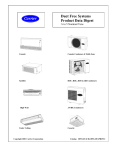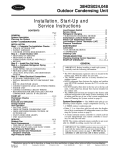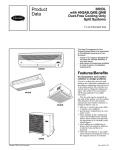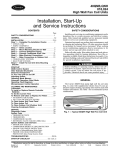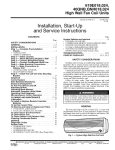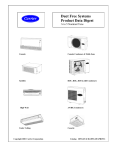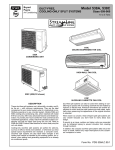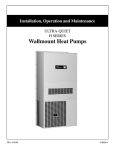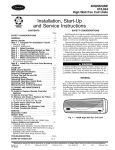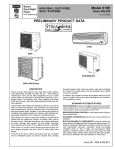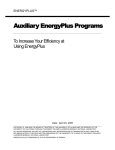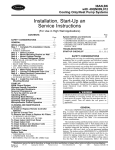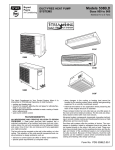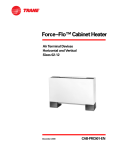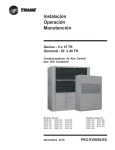Download Carrier 38HDL048 Specifications
Transcript
38HDL018-060 Light Commercial Condensing Units Installation, Start-Up and Service Instructions CONTENTS Page SAFETY CONSIDERATIONS . . . . . . . . . . . . . . . . . . . 1 INSTALLATION . . . . . . . . . . . . . . . . . . . . . . . . . . . . . . 1-7 Step 1 — Complete Pre-Installation Checks . . . . . . . . . . . . . . . . . . . . . . . . . . . . . . . . . . . . 1 • UNPACK UNIT • INSPECT SHIPMENT • CONSIDER SYSTEM REQUIREMENTS Step 2 — Rig and Mount Unit . . . . . . . . . . . . . . . . . 3 • MOUNTING ON GROUND • MOUNTING ON ROOF • RIGGING Step 3 — Complete Refrigerant Piping Connections . . . . . . . . . . . . . . . . . . . . . . . . . . . . . . . 3 • CHECK ACCURATERt CONTROL • MAKE PIPING SWEAT CONNECTIONS • PROVIDE SAFETY RELIEF Step 4 — Make Electrical Connections . . . . . . . . 4 • POWER WIRING • CONTROL CIRCUIT WIRING • CONNECTIONS TO DUCT-FREE FAN COIL UNITS Step 5 — Accessory Installation . . . . . . . . . . . . . . 4 START-UP . . . . . . . . . . . . . . . . . . . . . . . . . . . . . . . . . . . 7 SERVICE . . . . . . . . . . . . . . . . . . . . . . . . . . . . . . . . . . . 7-9 MAINTENANCE . . . . . . . . . . . . . . . . . . . . . . . . . . . . . 10 TROUBLESHOOTING . . . . . . . . . . . . . . . . . . . . . . . . 11 SAFETY CONSIDERATIONS Install and servicing air-conditioning equipment can be hazardous due to system pressure and electrical components. Only trained and qualified service personnel should install or service air-conditioning equipment Untrained personnel may perform basic maintenance such as cleaning and replacing filters. All other operations should be performed by trained service personnel. When working on air-conditioning equipment, observe safety precautions in literature, and on tags and labels attached to unit. Follow all safety codes. Wear safety glasses and work gloves. Use quenching cloth for brazing operations. Have a fire extinguisher available. Read these instructions thoroughly. Consult local building codes and National Electrical Code (NEC, U.S.A. Standard) for special installation requirements. COOLING Fig. 1 — 38HDL Condensing Unit Before installing or servicing system, always turn off main power to system. There may be more than one disconnect switch. Turn off accessory heater power if applicable. Electrical shock can cause personal injury. Step 1 — Complete Pre-Installation Checks UNPACK UNIT — Move unit to final location. Remove carton from unit, being careful not to damage service valves or grilles. INSPECT SHIPMENT — File claim with shipping company if shipment is damaged or incomplete. Check unit nameplate to ensure unit matches job requirements. CONSIDER SYSTEM REQUIREMENTS — Consult local building codes and NEC for special installation requirements. Allow sufficient space for airflow clearance, wiring, refrigerant piping, and servicing unit. See Fig. 1 and 2. Unit can be mounted on a level pad directly on base legs or mounted on raised pads at support points. See Fig. 2 for center of gravity. Manufacturer reserves the right to discontinue, or change at any time, specifications or designs without notice and without incurring obligations. Book 1 4 PC 111 Catalog No. 563-899 Printed in U.S.A. Form 38HDL-1SI Pg 1 9-98 Replaces: New Tab 3a 2a UNIT SIZE 38HDL 018 024 030 036 048 060 A ft-in. 2-11⁄8 2-11⁄8 2-11⁄8 2-11⁄8 3-13⁄16 3-13⁄16 B mm 638.2 638.2 638.2 638.2 944.6 944.6 ft-in. 3-015⁄16 3-015⁄16 3-015⁄16 3-015⁄16 3-89⁄16 3-89⁄16 C mm 938.2 938.2 938.2 938.2 1131.9 1131.9 ft-in. 1-29⁄16 1-29⁄16 1-29⁄16 1-29⁄16 1-51⁄16 1-51⁄16 D mm 369.9 369.9 369.9 369.9 433.4 433.4 ft-in. 1-4 1-4 1-4 1-4 1-67⁄16 1-67⁄16 E mm 406.4 406.4 406.4 406.4 468.3 468.3 ft-in. 1-117⁄16 1-117⁄16 1-117⁄16 1-117⁄16 2- 61⁄2 2- 61⁄2 F mm 595.3 595.3 595.3 595.3 774.7 774.7 ft-in. 1-53⁄16 1-53⁄16 1-53⁄16 1-53⁄16 1-75⁄8 1-75⁄8 G mm 436.6 436.6 436.6 436.6 498.5 498.5 ft-in. 1-51⁄2 1-51⁄2 1-51⁄2 1-51⁄2 2-55⁄8 2-55⁄8 H mm 444.5 444.5 444.5 444.5 752.5 752.5 ft-in. 1-81⁄8 1-81⁄8 1-81⁄8 1-81⁄8 2-83⁄16 2-83⁄16 J mm 511.2 511.2 511.2 511.2 817.6 817.6 UNIT SIZE 38HDL ft-in. 1-1 1-1 1-1 1-1 1-17⁄8 1-111⁄16 K mm 330.2 330.2 330.2 330.2 352.4 347.7 ft-in. 0-65⁄8 0-63⁄4 0-63⁄4 0-63⁄4 0-81⁄4 0-81⁄8 L mm 168.3 171.5 171.5 171.5 209.5 206.4 ft-in. 0-111⁄4 0-115⁄8 0-115⁄8 0-115⁄8 0- 4 0- 37⁄8 M mm 285.8 295.3 295.3 295.3 406.4 403.2 ft-in. 0-05⁄8 0-05⁄8 0-03⁄4 0-03⁄4 0-07⁄8 0-07⁄8 mm 15.88 15.88 19.05 19.05 22.22 22.22 OPERATING WEIGHT lb kg 130 58.9 136 61.6 161 73.0 185 83.9 222 100.5 249 112.9 MINIMUM MOUNTING PAD DIMENSIONS Support Feet Snow Stand Ice Stand ft-in. mm ft-in. mm ft-in. mm 018,024,030 1-11 x 3-6 584.2 x 1066.8 2-2 x 3-6 660.4 x 1066.8 2-2 x 3-6 660.4 x 1066.8 and 036 048 and 060 2- 0 x 4-2 609.6 x 1270.0 2-4 x 4-4 711.2 x 1270.0 2-2 x 4-2 660.4 x 1270.0 NOTES: 1. Required clearances: With coil facing wall, allow 69 (156.4 mm) minimum clearance on coil side and coil end, and 3 ft (914.4 mm) minimum clearance on compressor end and fan side. With fan facing wall, allow 89 (203.2 mm) minimum clearance on fan side and coil end, and 3 ft (914.4 mm) minimum clearance on compressor end and coil side. With multi-unit application, arrange units so discharge of one does not enter inlet of another. 2. Dimensions in parenthesis are in millimeters. 3. Center of gravity . 2 Fig. 2 — 38HDL018-060 — Dimensional Drawing Step 2 — Rig and Mount Unit MOUNTING ON GROUND — Mount unit on a solid, level concrete pad. Position unit so water or ice from roof does not fall directly into unit. Field-fabricated stacking kits can be used when units are to be stacked. If conditions or local codes require unit to be fastened to a pad, 6 field-supplied tiedown bolts should be used and fastened through slots provided in unit mounting feet. MOUNTING ON ROOF — Mount unit on level platform or frame at least 6 in. (154 mm) above roof surface. Isolate unit and tubing from structure. RIGGING Be sure unit panels are securely in place prior to rigging. Fig. 3 — Lifting Unit with Sling Keep unit upright. Lift unit using sling. Use cardboard or padding under sling, and spreader bars to prevent sling damage to unit. See Fig. 3. See Fig. 2 for center of gravity reference. Install unit so coil does not face into prevailing winds. If this is not possible and constant winds above 25 mph are expected, use field-fabricated wind baffle. NOTE: Field-fabricated wind baffles should be used on all units with accessory low-ambient control. Field-fabricated snow stand may be used to raise unit when operation will be required during the winter. Units may also be wall mounted using the accessory wall mounting kit. with field-replaceable piston should be supplied with the indoor unit. Refer to AccuRater metering device table in separate indoor unit installation instructions to determine the correct AccuRater piston size required for the condenser/evaporator system being installed. Note that one of 2 types of the AccuRater devices can be found on the indoor unit. See Fig. 4. Do not interchange components between AccuRater device types. Matching of outdoor unit with indoor unit may require field replacement of piston. Replace piston, if required, before connecting refrigerant lines. Piston replacement instructions are included in the indoor unit installation instructions. After system installation is complete, see Refrigerant charging section on page 8 to check and/or adjust refrigerant charge. The 38HDL018-060 units may also be installed with units using a thermostatic expansion valve (TXV). If a TXV is used, be sure to remove the piston from the indoor coil. See installation instructions shipped with the TXV for proper positioning and adjustment. Step 3 — Complete Refrigerant Piping Connections — Outdoor units may be connected to indoor units using field-supplied tubing of refrigerant grade and condition. See Tables 1A and 1B for correct line sizes. Do not use less than 10 ft (3 m) of interconnecting tubing. DO NOT BURY MORE THAN 36 IN. (922 mm) OF REFRIGERANT PIPE IN THE GROUND. If any section of pipe is buried, there must be a 6 in. (154 m) vertical rise to the valve connections on the outdoor unit. If more than the recommended length is buried, refrigerant may migrate to the cooler, buried section during extended periods of system shutdown. This causes refrigerant slugging and could damage compressor at start-up. When more than 50 ft (15.2 m) of interconnecting tubing and more than 30 ft (9.1 m) of vertical lift is used, refer to Part 3 of the Carrier System Design Manual for design details, or contact your local distributor. If either refrigerant tubing or indoor coil is exposed to atmospheric conditions for longer than 5 minutes, it must be evacuated to 1000 microns to eliminate contamination and moisture in the system. Run refrigerant tubes as directly as possible, avoiding unnecessary turns and bends. Suspend refrigerant tubes so they do not damage insulation on vapor tube and do not transmit vibration to the structure. Also, when passing refrigerant tubes through the wall, seal opening so that vibration is not transmitted to structure. Leave some slack in refrigerant tubes between structure and outdoor unit to absorb vibration. Refer to separate indoor unit installation instructions for additional information. CHECK ACCURATERt CONTROL — The correct AccuRater (bypass type) refrigerant control is required for cooling system capacity optimization. An AccuRater device TYPE A (BYPASS TYPE) TYPE B NOTE: Arrow on AccuRater body points in free-flow direction, away from the indoor coil. Fig. 4 — AccuRater Metering Device Components MAKE PIPING SWEAT CONNECTIONS — Remove plastic caps from liquid and suction service valves. Use refrigerant grade tubing. Service valves are closed from the factory and ready for brazing. After wrapping the service valve 3 in compliance with NEC (U.S.A. Standard) and applicable local codes. Use minimum 60 C wire for field power connection. Route power wires through opening in the unit side panel and connect in unit control box as shown on unit label diagram and Fig. 5 and 6. Unit must be grounded. CONTROL CIRCUIT WIRING — Control voltage is 24 v. See Fig. 5 and unit label diagram for field-supplied wiring details. Route control wire through opening in the unit side panel to connection in unit control box. NOTE: For wire runs up to 50 ft (15 m), use no. 18 AWG (American Wire Gage) insulated wire (35 C minimum). For 50 to 75 ft (15 to 23 m), use no. 16 AWG insulated wire. For more than 75 ft (23 m), use no. 14 AWG insulated wire. See Table 2 for conversion to European wire sizes. NOTE: Operation of unit on improper line voltage constitutes abuse and could affect Carrier warranty. See Table 3. Do not install unit in system where voltage may fluctuate above or below permissible limits. See Table 3 for recommended fuse sizes. When making electrical connections, provide clearance at unit for refrigerant piping connections. Use indoor unit transformer as 24-v (40-va minimum) supply for system as shown in Fig. 5 or use accessory transformer. with a wet cloth, the tubing set can be brazed to the service valve using either silver bearing or non-silver bearing brazing material. Consult local code requirements. Refrigerant tubing and indoor coil are ready for leak testing. NOTE: Unit is shipped with R-22 full factory charge indicated on nameplate. Pass nitrogen or other inert gas through piping while brazing to prevent formation of copper oxide. To avoid damage while brazing, service valves should be wrapped in a heat-sinking material such as a wet cloth. When brazing tubing sets to the service valves, a brazing shield must be used to prevent damage to the painted unit surface. PROVIDE SAFETY RELIEF — A fusible plug is located in unit suction line; do not cap this plug. If local code requires additional safety devices, install as directed. Step 4 — Make Electrical Connections Unit cabinet must have an uninterrupted, unbroken electrical ground to minimize the possibility of personal injury if an electrical fault should occur. This ground may consist of electrical wire connected to the unit ground lug in control compartment, or conduit approved for electrical ground when installed in accordance with NEC, ANSI/NFPA (American National Standards Institute/National Fire Protection Association) 70 (U.S.A. Standards), and local electrical codes. Failure to follow this warning could result in the installer being liable for personal injury to others. Before performing service or maintenance, be sure the indoor unit main power switch is off and indoor blower has completely stopped. Failure to do so may result in electrical shock or injury from rotating fan blades. CONNECTIONS TO DUCT-FREE FAN COIL UNITS — The 38HDL units are designed for easy match-up to 40QAB, 40QKB, and 40QNB018,024 duct-free fan coils. These units provide 24-v power for the outdoor unit from the fan coil. Connect the Y and C terminals of the indoor unit to the blue and brown wires of the outdoor unit with 20 gage (minimum) thermostat wire. Unit failure as a result of operation on improper line voltage or excessive phase imbalance constitutes abuse and may cause damage to electrical components. Such operation will invalidate any applicable Carrier warranty. Step 5 — Accessory Installation — Install all unit accessories per accessory installation instructions prior to start-up. Do not use accessory Time Guardt II device when combining a 38HDL unit with 40QNB indoor units. When ambient temperature will fall below 55 F (13 C), accessory low ambient controller (part no. 53DS900060) is required. When accessory low ambient kit is used, unit should also be equipped with accessory winter start kit and fieldfabricated wind baffles. POWER WIRING — Unit is factory-wired for voltage shown on nameplate. Provide adequate, fused disconnect switch within sight of unit, readily accessible but out of reach of children. Provision for locking the switch open (off) is advisable to prevent power from being turned on while unit is being serviced. Disconnect switch, fuses, and field wiring must be 4 Table 1A — Physical Data (English) UNIT 38HDL NOMINAL CAPACITY (Btuh) UNIT OPERATING WEIGHT (lb) COMPRESSOR Type Model Oil (oz) Initial/Recharge OUTDOOR FAN Rpm Diameter (in.)...No. of Blades Fan Pitch (Deg) Motor Hp Nominal Airflow (Cfm) OUTDOOR COIL Face Area (sq ft)...No. of Rows Fins per in. CONTROLS PRESSURESTAT SETTINGS Low Pressure Cutout (psig) Cut-In (psig) Fusible Plug 018 18,000 130 024 24,000 136 Copeland Scroll ZR18KC-PFV 25/21 850 18...3 25 1⁄8 1720 6.1...1 20 030 30,000 161 036 36,000 185 048 48,000 222 Hermetic Copeland Copeland Tecumseh Copeland Scroll Scroll Reciprocating Scroll ZR24KC-PFV ZR28KC-PFV AV5535G ZR47KC-PFV 25/21 38/34 54/50 42/38 Propeller Type, Direct Drive, Horizontal 850 850 850 850 18...3 18...3 18...3 24...3 27 27 31 24 1⁄8 1⁄8 1 ⁄8 1⁄4 1720 1720 1720 3900 Copper Tube, Aluminum Plate Fin 6.1...1.5 6.1...2 6.1...2 12.3...1.5 20 20 20 20 060 60,000 249 Copeland Scroll ZR57KC-PFV 56/52 850 24...3 24 1⁄4 3900 12.3...1.75 20 7±3 22 ± 5 210 F NOTE: Line sizes are for runs up to 25 feet. Table 1B — Physical Data (SI) UNIT 38HDL NOMINAL CAPACITY (kW) UNIT OPERATING WEIGHT (kg) COMPRESSOR Type Model Oil (L) Initial/Recharge OUTDOOR FAN R/s Diameter (mm)...No. of Blades Fan Pitch (Deg) Motor kW Nominal Airflow (L/s) OUTDOOR COIL Face Area (m2)...No. of Rows Fins per mm CONTROLS PRESSURESTAT SETTINGS Low Pressure Cutout (kPa) Cut-In (kPa) Fusible Plug 018 5.3 58.9 024 7.0 61.6 030 8.8 73.0 Copeland Scroll ZR18KC-PFV .74/.62 Copeland Scroll ZR24KC-PFV .74/.62 14.2 457...3 25 .13 812 14.2 457...3 27 .09 812 .57...1 .8 .57...1.5 .8 036 10.5 83.9 048 14.1 100.6 Hermetic Copeland Tecumseh Copeland Scroll Reciprocating Scroll ZR28KC-PFV AV5535G ZR47KC-PFV 1.13/1.00 1.60/1.48 1.25/1.13 Propeller Type, Direct Drive, Horizontal 14.2 14.2 14.2 457...3 457...3 610...3 27 31 24 .09 .09 .19 812 812 1840 Copper Tube, Aluminum Plate Fin .57...2 .57...2 1.14...1.5 .8 .8 .8 48 ± 21 152 ± 34 99 C NOTE: Line sizes are for runs up to 7.6 m. 5 060 17.6 112.9 Copeland Scroll ZR57KC-PFV 1.66/1.54 14.2 610...3 24 .19 1840 1.14...1.75 .8 C HC IFM IFR TRANS — — — — — LEGEND Contactor (12-va) Heating Control Indoor-Fan Motor Indoor-Fan Relay Transformer Field Wiring Factory Wiring *The IFR and IFM are located in indoor unit on heating-cooling applications. If accessory IFR is required for cooling-only applictions, locate (IFR) in fan coil. NOTE: Refer to unit wiring label for wire colors: BRN to BLU and C to Y connections. Fig. 5 — Typical Control Circuit Connections LEGEND NEC — National Electrical Code TB — Terminal Board TB Connections Field Wiring Factory Wiring Fig. 6 — Line Power Connections 6 Table 2 — American/European Wire Conversions Industry Standard Size 18 AWG 16 AWG 14 AWG 12 AWG 10 AWG 8 AWG 6 AWG 4 AWG 3 AWG 2 AWG 1 AWG 1/0 AWG 2/0 AWG 3/0 AWG 4/0 AWG 250 kcmil 300 kcmil 350 kcmil 400 kcmil 500 kcmil 600 kcmil AMERICAN American Conversion (mm) 0.82 1.30 2.08 3.30 5.25 6.36 13.29 21.14 26.65 33.61 42.39 53.49 67.42 85.00 107.19 126.64 151.97 177.90 202.63 253.29 303.95 SERVICE EUROPEAN Industry Standard Size (mm2) 1.0 1.5 2.5 4.0 6.0 10.0 16.0 25.0 — 35.0 50.0 — 70.0 95.0 120.0 150.0 — 185.0 240.0 300.0 — Before performing recommended maintenance, be sure unit main power switch is off. Failure to do so may result in electrical shock or injury from rotating fan blade. Outdoor Fan — A reinforced wire mount holds the outdoor fan assembly in place. See Fig. 7 for proper mounting positions. 38HDL018 0.433 (11) LEGEND AWG — American Wire Gage kcmil — Thousand Circular Mils DIMENSIONS — in. (mm) 38HDL024-036 38HDL048-060 0.709 (18) 0.16 (4) Fig. 7 — Condenser Fan Mounting Positions High-Pressure Relief Valve — Valve is located in compressor. Relief valve opens at a pressure differential of approximately 450 ± 50 psig (3100 ± 345 kPa) between suction (low side) and discharge (high side) to allow pressure equilization. START-UP Preliminary Checks 1. Check that all internal wiring connections are tight and that barriers, covers, and panels are in place. 2. Make certain field electrical power source agrees with unit nameplate rating. 3. Open all service valves. Internal Current and Temperature Sensitive Overload — Control resets automatically when internal compressor motor temperature drops to a safe level (overloads may require up to 45 minutes to reset). When an internal overload is suspected of being open, check by using an ohmmeter or continuity tester. If necessary, refer to Carrier Standard Systems Techniques Manual, Chapter 2, for complete information. Leak Test — Field piping and fan coil must be leak tested by pressure method described in Carrier Standard Service Techniques Manual, Chapter 1, Section 1-6. Use R-22 at approximately 25 psig (172 kPa) backed up with an inert gas to a total pressure not to exceed 245 psig (1690 kPa). Pumpdown Procedure — The system may be pumped down in order to make repairs on low side without losing complete refrigerant charge. To pumpdown: 1. Attach pressure gage to suction service valve gage port. 2. Frontseat the liquid line valve. Evacuate and Dehydrate — Field piping and fan coil must be evacuated and dehydrated by either of the methods described in Carrier Standard Service Techniques Manual, Chapter 1, Section 1-7. Charge System — Release factory charge into system by opening (backseating) liquid and suction line service valves. Add charge amount as required for the total system. Refer to separate indoor unit installation instructions for the required total system charge when connected to the indoor unit. The 38HDL unit coils hold only the factory-designated amount of refrigerant. Additional refrigerant may cause units to relieve pressure through compressor internal pressure relief valve (indicated by sudden rise of suction pressure) before suction pressure reaches 5 psig (34 kPa). If this occurs, shut off unit immediately, then frontseat the suction valve and remove and reclaim excess refrigerant following accepted practice. To Start Unit NOTE: When using in conjunction with 40QAB, 40QKB, or 40QNB fan coils, refer to start-up instructions included with fan coil for correct start-up procedures. Be sure that field disconnect is closed. Set room thermostat below ambient temperature. Operate unit for 15 minutes, then check system refrigerant charge. See Refrigerant Charging section on page 8. Unit compressor starts after a 5-minute delay if equipped with accessory Time Guardt II device. 3. Start unit and run until suction pressure reaches 5 psig (34 kPa). 4. Shut unit off and frontseat suction valve. 5. Depressurize low side of unit and recover refrigerant following accepted practice. 7 Table 3 — Electrical Data UNIT SIZE 38HDL 018 024 030 036 048 060 V-PH-Hz OPERATIONAL VOLTAGE* Min 208/230-1-60 187 COMPRESSOR POWER SUPPLY Max RLA LRA Fan FLA MCA 254 10.7 13.2 15.7 14.2 24.3 28.6 47.0 59.0 73.0 86.7 131.0 170.0 .70 .70 .70 .70 1.45 1.45 14.1 17.2 20.3 18.5 31.8 37.2 Max Fuse† or HACR-Type Ckt Bkr Amps 25 30 35 30 50 65 LEGEND FLA — Full Load Amps HACR — Heating, Air Conditioning, Refrigeration LRA — Locked Rotor Amps MCA — Minimum Circuit Amps per NEC Section 430-24 NEC — National Electrical Code (U.S.A. Standard) RLA — Rated Load Amps (Compressor) *Permissible limits of the voltage range at which unit will operate satisfactorily. †Time-delay fuse. NOTES: 1. Control circuit is 24 v on all units and requires an external power source. 2. All motors and compressors contain internal overload protection. 3. In compliance with NEC (U.S.A. Standard) requirements for multimotor and combination load equipment (refer to NEC Articles 430 and 440), the overcurrent protective device for the unit shall be fuse or HACR breaker. 4. Motor RLA values are established in accordance with UL (Underwriters’ Laboratories) Standard 465 (U.S.A. Standard). Low Pressure Switch — This switch, mounted on the 7. Replace retainer O-ring before reassembling AccuRater device (O-ring part no. 99CC501052). suction line, has fixed non-adjustable settings. To check pressure switch, attach pressure gage to suction service valve gage port. Slowly close liquid shutoff valve and allow compressor to pump down. Do not allow compressor to pump down below 2 psig (14 kPa). Compressor should shut down when suction pressure drops to cutout pressure in Tables 1A and 1B, and should restart when pressure builds up to cut-in pressure shown after accessory CLO (compressor lockout) switch has been reset and accessory Time Guardt II device has completed its timing cycle. Refrigerant Charging To prevent personal injury, wear safety glasses and gloves when handling refrigerant. Do not overcharge system — this can cause compressor flooding. NOTE: Do not vent or depressurize unit refrigerant to atmosphere. Remove and reclaim refrigerant following practice. SUPERHEAT METHOD (COOLING, NON-TXV) — To check and adjust charge during cooling season, use Tables 4A-5B and the following procedure: 1. Operate unit a minimum of 15 minutes before checking charge. 2. Measure suction pressure by attaching a gage to suction valve service port. 3. Measure suction line temperature by attaching a service thermometer to unit suction line near suction valve. Insulate thermometer for accurate readings. 4. Measure outdoor coil inlet-air dry bulb temperature with a second thermometer. 5. Measure indoor coil inlet-air wet bulb temperature with a sling psychrometer. 6. Refer to Tables 4A and 4B. Find air temperature entering outdoor coil and wet-bulb temperature entering indoor coil. At this intersection, note the superheat temperature. 7. Refer to Tables 5A and 5B. Find superheat temperature and suction pressure and note suction line temperature. 8. If unit has higher suction line temperature than charted temperature, add refrigerant until charted temperature, add refrigerant until charted temperature is reached. 9. If unit has lower suction line temperature than charted temperature, remove and recover refrigerant until charted temperature is reached. 10. If air temperature entering outdoor coil or pressure at suction valve changes, charge to new suction line temperature indicated on chart. NOTE: The above procedure is independent of indoor air quantity. Service Valves — The service valves in the outdoor unit come from the factory frontseated. This means the refrigerant charge is isolated from the line-set connection ports. To prevent damage to the valve, use a wet cloth or other acceptable heat sink material on the valve before brazing. The service valves must be backseated (turned counterclockwise until seated) before the service port caps can be removed and the hoses of the gage manifold connected. In this position, refrigerant has access from the through outdoor and indoor unit. The service valve cannot be field repaired; only a complete valve or valve stem seal and service port caps are available for replacement. AccuRaterT (Bypass Type) Device — See Fig. 4 for bypass type AccuRater device components. The piston has a refrigerant metering hole through it. The retainer forms a stop for the piston in the refrigerant bypass mode and a sealing surface for liquid line flare connection. To check, clean or replace piston: 1. Shut off power to unit. 2. Pump down using Pumpdown Procedure section on page 7. 3. Remove liquid line flare connection from AccuRater device. 4. Pull retainer out of body, being careful not to scratch flare sealing surface. If retainer does not pull out easily, carefully use locking pliers to remove retainer. 5. Slide piston out by inserting a small soft wire, with small kinks, through metering hole. Ensure metering hole, sealing surface around piston cones, and fluted portion of piston are not damaged. 6. Clean piston refrigerant metering hole. 8 Table 5A — Required Suction-Tube Temperature (F) — English (Entering Suction Service Valve) SUBCOOLING METHOD (COOLING, TXV) — To check and adjust charge during cooling season, use Tables 6A and 6B and the following procedure: 1. Operate unit a minimum of 15 minutes before checking charge. 2. Measure liquid line temperature near liquid line service valve, and measure liquid pressure at liquid line service valve. Use a digital thermometer for all temperature measurements. DO NOT use mercury or dial-type thermometers. 3. Refer to Tables 6A and 6B. Find temperature point at which the required subcooling temperature intersects the measured liquid line pressure. 4. If the measured liquid line temperature does not agree with the required liquid line temperature, ADD refrigerant to lower the temperature, or REMOVE refrigerant to raise the temperature (allow a tolerance of ± 3 F). SUPERHEAT SUCTION PRESSURE AT SERVICE PORT (psig) TEMP (F) 61.5 64.2 67.1 70.0 73.0 76.0 79.2 82.4 85.7 0 35 36 39 41 43 45 47 49 51 2 37 39 41 43 45 47 49 51 53 4 39 41 43 45 47 49 51 53 55 6 41 43 45 47 49 51 53 55 57 8 43 45 47 49 51 53 55 57 59 10 45 47 49 51 53 55 57 59 61 12 47 49 51 53 55 57 59 61 63 14 49 51 53 55 57 59 61 63 65 16 51 53 55 57 59 61 63 65 67 18 53 55 57 59 61 63 65 67 69 20 55 57 59 61 63 65 67 69 71 22 57 59 61 63 65 67 69 71 73 24 59 61 63 65 67 69 71 73 75 26 61 63 65 67 69 71 73 75 77 28 63 65 67 69 71 73 75 77 79 30 65 67 69 71 73 75 77 79 81 32 67 69 71 73 75 77 79 81 83 34 69 71 73 75 77 79 81 83 85 36 71 73 75 77 79 81 83 85 87 38 73 75 77 79 81 83 85 87 89 40 75 77 79 81 83 85 87 89 91 Table 4A — Superheat Charging Table — English (Superheat Entering Suction Service Valve) OUTDOOR TEMP (F) 50 55 9 60 7 65 * 70 * 75 * 80 * 85 * 90 * 95 * 100 * 105 * 110 * 115 * 52 12 10 6 * * * * * * * * * * INDOOR COIL ENTERING AIR (F) 54 56 58 60 62 64 66 68 70 14 17 20 23 26 29 32 35 37 12 15 18 21 24 27 30 33 35 10 13 16 19 21 24 27 30 33 7 10 13 16 19 21 24 27 30 * 6 9 12 15 18 21 24 28 * * 5 8 12 15 18 21 25 * * * * 8 11 15 19 22 * * * * 5 9 13 16 20 * * * * * 6 10 14 18 * * * * * * 8 12 15 * * * * * * 5 9 13 * * * * * * * 6 11 * * * * * * * * 8 WB 72 74 40 42 38 40 36 38 33 36 31 34 28 31 26 30 24 27 22 25 20 23 17 22 15 20 14 18 76 45 43 41 39 37 35 33 31 29 27 26 25 23 Table 5B — Required Suction-Tube Temperature (C) — SI (Entering Suction Service Valve) OUTDOOR SUCTION TEMP (C) 424 443 0 2 3 1 3 4 2 4 5 3 5 6 4 6 7 6 7 8 7 8 9 8 9 11 9 11 12 10 12 13 11 13 14 12 14 15 13 15 16 14 16 17 16 17 18 17 18 19 18 19 21 19 21 22 20 22 23 21 23 24 22 24 25 LEGEND WB — Wet Bulb *Do not attempt to charge system under these conditions or refrigerant slugging may occur. Table 4B — Superheat Charging Table — SI (Superheat Entering Suction Service Valve) OUTDOOR TEMP (C) 10 13 5 16 4 18 * 21 * 24 * 27 * 29 * 32 * 35 * 38 * 41 * 43 * 46 * 11 7 6 3 * * * * * * * * * * INDOOR COIL ENTERING AIR (C) WB 12 13 14 16 17 18 19 20 21 22 23 8 9 11 13 14 16 18 19 21 22 23 7 8 10 12 13 15 17 18 19 21 22 6 7 9 11 12 13 15 17 18 20 21 4 6 7 9 11 12 13 15 17 18 20 * 3 5 7 8 10 12 13 16 17 19 * * 3 4 7 8 10 12 14 16 17 * * * * 4 6 8 11 12 14 17 * * * * 3 5 7 9 11 13 15 * * * * * 3 6 8 10 12 14 * * * * * * 4 7 8 11 13 * * * * * * 3 5 7 9 12 * * * * * * * 3 6 8 11 * * * * * * * * 4 8 10 24 25 24 23 22 21 19 18 17 16 15 14 14 13 LEGEND WB — Wet Bulb *Do not attempt to charge system under these conditions or refrigerant slugging may occur. 9 PRESSURE AT SERVICE PORT (kPa) 463 483 503 524 546 568 591 4 5 6 7 8 9 11 5 6 7 8 9 11 12 6 7 8 9 11 12 13 7 8 9 11 12 13 14 8 9 11 12 13 14 15 9 11 12 13 14 15 16 11 12 13 14 15 16 17 12 13 14 15 16 17 18 13 14 15 16 17 18 19 14 15 16 17 18 19 21 15 16 17 18 19 21 22 16 17 18 19 21 22 23 17 18 19 21 22 23 24 18 19 21 22 23 24 25 19 21 22 23 24 25 26 21 22 23 24 25 26 27 22 23 24 25 26 27 28 23 24 25 26 27 28 29 24 25 26 27 28 29 31 25 26 27 28 29 31 32 26 27 28 29 31 32 33 COMPRESSOR — Compressor contains factory oil charges; replace oil when lost. See Tables 1A and 1B for oil recharge and refer to Carrier Standard Service Techniques Manual, Chapter 1, pages 1 to 21 for oil recharging procedure. See Table 7 for recommended compressor oils. MAINTENANCE Before performing recommended maintenance, be sure unit main power is off. Failure to do so may result in electrical shock or injury from rotating fan blades. Cleaning Coils — Coil should be washed out with water or blown out with compressed air. Note that the blowthru design causes dirt and debris to build up on the inside of the coils. Clean coil annually or as required by location and outdoor air conditions. Inspect coil monthly and clean as required. Fins are NOT continuous through coil sections. Dirt and debris may pass through the first section, become trapped between the rows of fins, and restrict condenser airflow. Use a flashlight to determine if dirt or debris has collected between coil sections. Clean coil as follows: 1. Turn off unit power. 2. Use a garden hose or other suitable equipment to flush coil from the outside to remove dirt. Be sure to flush all dirt and debris from drain holes in the base of unit. Fan motors are waterproof. Lubrication FAN-MOTOR BEARINGS — Oiling holes are provided at each end of the condenser-fan motor. Remove fan motor and lubricate motor with 32 drops (16 drops per hole) of SAE-10 (Society of Automotive Engineers) non-detergent oil at intervals described below: • Annually, when environment is very dirty, ambient temperature is higher than 105 F (40 C), and average unit operating time exceeds 15 hours a day, or • Every three years, when environment is reasonably clean, ambient temperature is less than 105 F (40 C), and unit operating time averages 8 to 15 hours per day, or • Every 5 years when environment is clean, ambient temperature is less than 105 F (40 C), and unit operating time averages less than 8 hours per day. Table 6A — Required Liquid Line Temperature (F) — English (At Service Valve) REQUIRED SUBCOOLING (F) 0 5 10 15 20 25 134 76 71 66 61 56 51 141 79 74 69 64 59 54 148 82 77 72 67 62 57 156 85 80 75 70 65 60 163 88 83 78 73 68 63 171 91 86 81 76 71 66 179 94 89 84 79 74 69 187 97 92 87 82 77 72 LIQUID PRESSURE AT SERVICE VALVE (PSIG) 196 205 214 223 233 243 253 264 100 103 106 109 112 115 118 121 95 98 101 104 107 110 113 116 90 93 96 99 102 105 108 111 85 88 91 94 97 100 103 106 80 83 86 89 92 95 98 101 75 78 81 84 87 90 93 96 274 124 119 117 109 104 99 285 127 122 120 112 107 102 297 130 125 123 115 110 105 309 133 128 126 118 113 108 321 136 131 129 121 116 111 331 139 134 129 124 119 114 346 142 137 132 127 122 117 359 145 140 135 130 125 120 2222 58 56 54 52 50 48 46 44 2264 59 57 55 53 51 49 47 45 2379 61 59 57 55 53 51 49 47 2475 63 61 59 57 55 53 51 49 Table 6B — Required Liquid Line Temperature (C) — SI (At Service Valve) REQUIRED SUBCOOLING (C) 0 2 4 6 8 10 12 14 911 24 22 20 18 16 14 12 10 969 26 24 22 20 18 16 14 12 1030 28 26 24 22 20 18 16 14 1061 29 27 25 23 21 19 17 15 1121 31 29 27 25 23 21 19 17 1186 33 31 29 27 25 23 21 19 1219 34 32 30 28 26 24 22 20 1286 36 34 32 30 28 26 24 22 LIQUID PRESSURE AT SERVICE VALVE (PSIG) 1360 1397 1471 1547 1588 1671 1755 1800 38 39 41 43 44 46 48 49 36 37 39 41 42 44 46 47 34 35 37 39 40 42 44 45 32 33 35 37 38 40 42 43 30 31 33 35 36 38 40 41 28 29 31 33 34 36 38 39 26 27 29 31 32 34 36 37 24 25 27 29 30 32 34 35 Table 7 — Recommended Compressor Oils RECOMMENDED OIL 018 024 3GS Calumet RO-15 Sontex 200LT • • UNIT 38HDL 030 036 • • • 048 060 • • 10 1885 51 49 47 45 43 41 39 37 1976 53 51 49 47 45 43 41 39 2026 54 52 50 48 46 44 42 40 2125 56 54 52 50 48 46 44 42 TROUBLESHOOTING CHART — COOLING CYCLE TROUBLESHOOTING 11 Copyright 1998 Carrier Corporation Manufacturer reserves the right to discontinue, or change at any time, specifications or designs without notice and without incurring obligations. Book 1 4 PC 111 Catalog No. 563-899 Printed in U.S.A. Form 38HDL-1SI Pg 12 9-98 Replaces: New Tab 3a 2a













